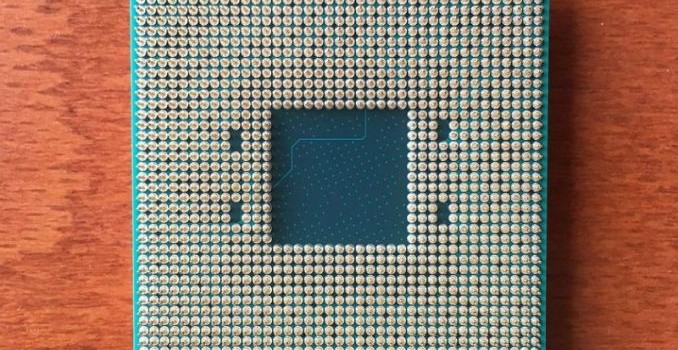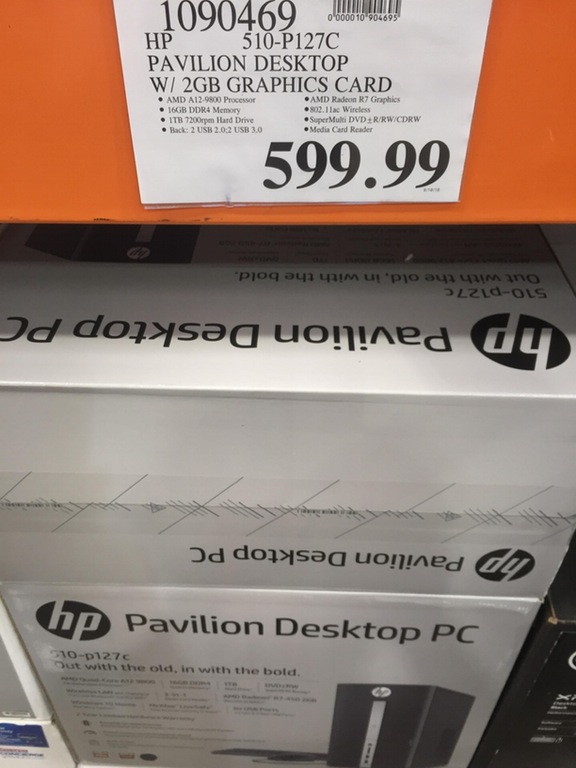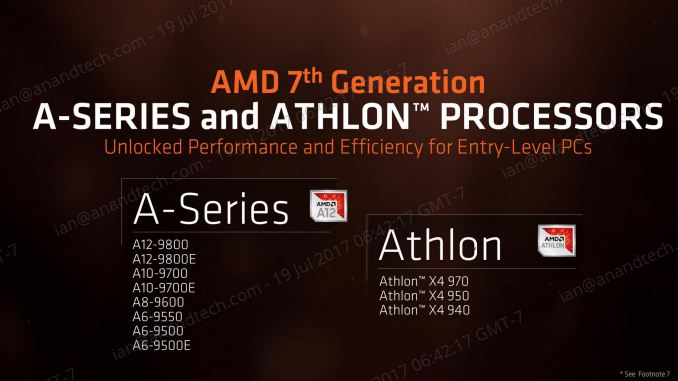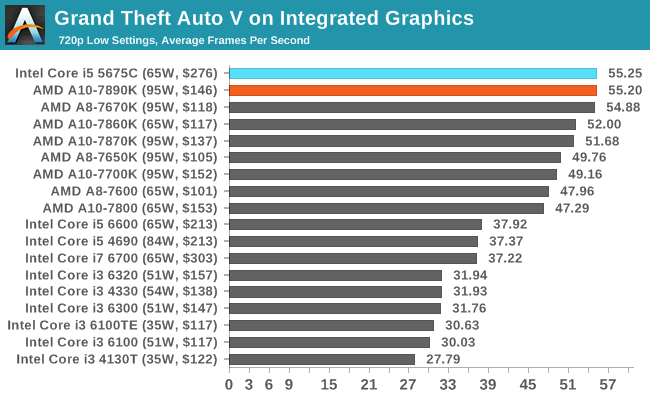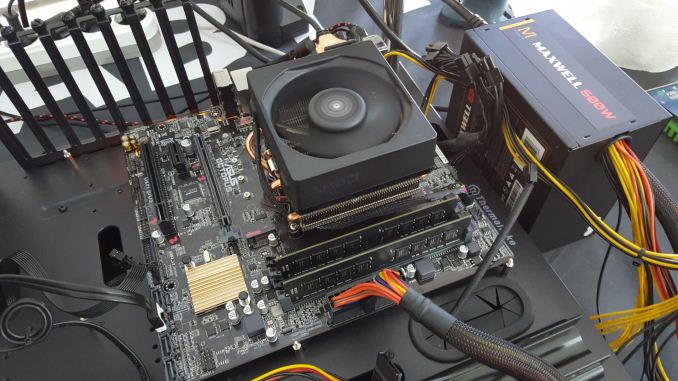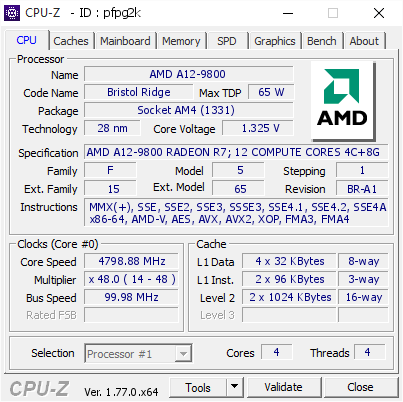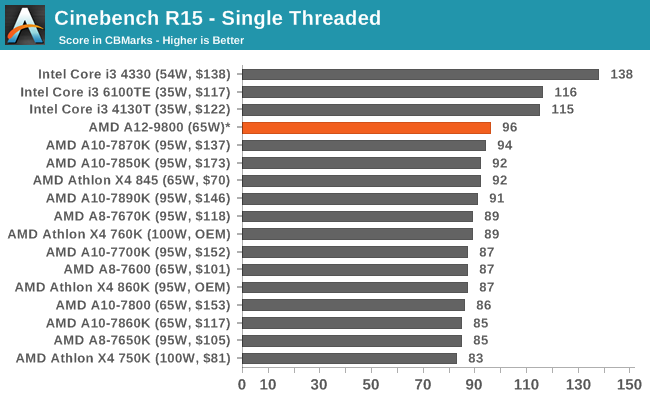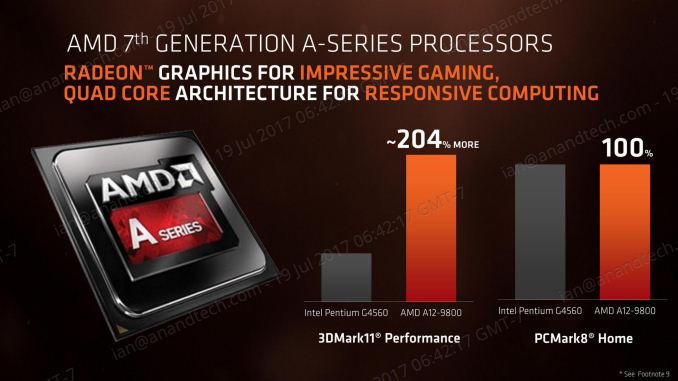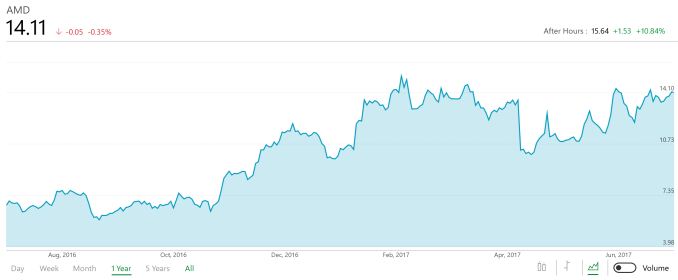AMD Releases Bristol Ridge to Retail: AM4 Gets APUs
The focus for AMD’s AM4 platform is to span a wide range of performance and price points. We’ve had the launch of the Ryzen CPU family, featuring quad cores up to octa-cores with the new Zen microarchitecture, but AM4 was always designed to be a platform that merges CPUs and integrated graphics. We’re still waiting for the new Zen cores in products like Ryzen to find their way down into the desktop in the form of the Raven Ridge family, however those parts are going through the laptop stack first and will likely appear on the desktop either at the end of the year or in Q1 next year. Until then, users get to play with Bristol Ridge, originally released back in September 2016, but finally making its way to retail.
First the OEMs, Now Coming To Retail
Back in 2016, AMD released Bristol Ridge to OEMs only. These parts were the highest performing iteration of AMD’s Bulldozer design, using Excavator v2 cores on an AM4 motherboard and using DDR4. We saw several systems from HP and others that used proprietary motherboard designs (as the major OEMs do) combined with these CPUs at entry level price points. For example, a base A12-9800 system with an R7 200-series graphics card was sold around $600 at Best Buy. Back at launch, Reddit user starlightmica saw this HP Pavilion 510-p127c in Costco:
$600 gets an A12-9800, 16GB of DDR4, a 1TB mechanical drive, an additional R7 2GB graphics card, 802.11ac WiFi, a DVDRW drive, and a smattering of USB ports.
Initially AMD’s focus on this was more about B2B sales. AMD’s reasoning for going down the OEM only route was one of control and marketing, although one might suggest that by going OEM only, it allowed distributors to clear their stocks of the previous generation APUs before Ryzen hit the shelves.
Still, these were supposed to be the highest performing APUs that AMD has ever made, and users still wanted a piece of the action. If you were lucky, a part might pop up from a broken down system on eBay, but for everyone else, the question has always been when AMD would make them available through regular retail channels. The answer is today, with a worldwide launch alongside Ryzen 3. AMD states that the Bristol Ridge chips aren’t designed to be hyped up as the biggest thing, but fill in the stack of CPUs below $130, an area where AMD has had a lot of traction in the past, and still provide the best performance-per-dollar APU on the market.
The CPUs
The eight APUs and three CPUs being launched f spans from a high-frequency A12 part to the A6, and they all build on the Bristol Ridge notebook parts that were launched in 2016. AMD essentially skipped the 6th Gen, Carrizo, for desktop as the Carrizo design was significantly mobile focused (for Carrizo we ended up with one CPU, the Athlon X4 845 (which we reviewed), with DDR3 support but no integrated graphics). Using the updated 28nm process from TSMC, AMD was able to tweak the microarchitecture and allow full on APUs for desktops using a similar design.
The table of ‘as many specifications as we could get our hands on’ is as follows:
| AMD 7th Generation Bristol Ridge Processors | |||||
| Modules/ Threads |
CPU Base / Turbo (MHz) |
GPU | GPU Base / Turbo (MHz) |
TDP | |
| A12-9800 | 2M / 4T | 3800 / 4200 | Radeon R7 | 800 / 1108 | 65W |
| A12-9800E | 2M / 4T | 3100 / 3800 | Radeon R7 | 655 / 900 | 35W |
| A10-9700 | 2M / 4T | 3500 / 3800 | Radeon R7 | 720 / 1029 | 65W |
| A10-9700E | 2M / 4T | 3000 / 3500 | Radeon R7 | 600 / 847 | 35W |
| A8-9600 | 2M / 4T | 3100 / 3400 | Radeon R7 | 655 / 900 | 65W |
| A6-9550 | 1M / 2T | 3800 / 4000 | Radeon R5 | 576 / 800 | 65W |
| A6-9500 | 1M / 2T | 3500 / 3800 | Radeon R5 | 720 / 1029 | 65W |
| A6-9500E | 1M / 2T | 3000 / 3400 | Radeon R5 | 576 / 800 | 35W |
| Athlon X4 970 | 2M / 4T | 3800 / 4000 | – | – | 65W |
| Athlon X4 950 | 2M / 4T | 3500 / 3800 | – | – | 65W |
| Athlon X4 940 | 2M / 4T | 3200 / 3600 | – | – | 65W |
AMD’s new entry-level processors will hit a maximum of 65W in their official thermal design power (TDP), with the launch offering a number of 65W and 35W parts. There was the potential to offer CPUs with a configurable TDP, as with previous APU generations, however much like the older parts that supported 65W/45W modes, it was seldom used, and chances are we will see system integrators stick with the default design power windows here. Also, the naming scheme: any 35W part now has an ‘E’ at the end of the processor name, allowing for easier identification.
Back when these CPUs were first launched, we were able to snag a few extra configuration specifications for each of the processors, including the number of streaming processors in each, base GPU frequencies, base Northbridge frequencies, and confirmation that all the APUs launched will support DDR4-2400 at JEDEC sub-timings.
The A12-9800 at the top of the stack is an interesting part on paper. If we do a direct comparison with the previous high-end AMD APUs, the A10-7890K, A10-7870K and A10-7860K, a lot of positives end up on the side of the A12.
| AMD Comparison | |||||||||
| Ryzen 3 1200 | A12-9800 | A10-7890K | A10-7870K | A10-7860K | A10-9700 | ||||
| MSRP | $109 | ? | $165 | $137 | $117 | ? | |||
| Platform | Ryzen | Bristol | Kaveri Refresh | Bristol | |||||
| uArch | Zen | Excavator | Steamroller | Excavator | |||||
| Threads | 4C / 4T | 2M / 4T | 2M / 4T | 2M / 4T | |||||
| CPU Base | 3100 | 3800 | 4100 | 3900 | 3600 | 3500 | |||
| CPU Turbo | 3400 | 4200 | 4300 | 4100 | 4000 | 3800 | |||
| IGP SPs | – | 512 | 512 | 384 | |||||
| GPU Turbo | – | 1108 | 866 | 866 | 757 | 1029 | |||
| TDP | 65W | 65W | 95W | 95W | 65W | 65W | |||
| L1-I Cache | 4×64 KB | 2×96 KB | 2×96 KB | 2×96 KB | |||||
| L1-D Cache | 4×32 KB | 4×32 KB | 4×16 KB | 4×32 KB | |||||
| L2 Cache | 4×512 KB | 2×1 MB | 2×2 MB | 2×1 MB | |||||
| L3 Cache | 8 MB | – | – | – | – | – | |||
| DDR Support | DDR4-2667 DDR4-2400 |
DDR4-2400 | DDR3-2133 | DDR4-2400 | |||||
| PCIe 3.0 | x16 | x8 | x16 | x16 | x16 | x8 | |||
| Chipsets | B350 A320 X/B/A300 |
B350 A320 X/B/A300 |
A88X A78 A68H |
B350 A320 X/B/A300 |
|||||
The frequency of the A12-9800 gives it a greater dynamic range than the A10-7870K (having 3.8-4.2 GHz, rather than 3.9-4.1), but with the Excavator v2 microarchitecture, improved L1 cache, AVX 2.0 support and a much higher integrated graphics frequency (1108 MHz vs. 866 MHz) while also coming in at 30W less TDP. The 30W TDP jump is the most surprising – we’re essentially getting better than the previous A10-class performance at a lower power, which is most likely why they started naming the best APU in the stack an ‘A12’. Basically, the A12-9800 APU will be an extremely interesting one to review given the smaller L2 cache but faster graphics and DDR4 memory.
One thing users will notice is the PCIe support: these Bristol Ridge APUs only have PCIe 3.0 x8 for graphics. This means that most X370 motherboards that have two GPU slots will leave the second slot useless. AMD suggests moving to B350 instead, which only allows one add-in card.
The Integrated GPU
For the A-series parts, integrated graphics is the name of the game. AMD configures the integrated graphics in terms of Compute Units (CUs), with each CU having 64 streaming processors (SPs) using GCN 1.3 (aka GCN 3.0) architecture, the same architecture as found in AMD’s R9 Fury line of GPUs. The lowest processor in the stack, the A6-9500E, will have four CUs for 256 SPs, and the A12 APUs will have eight CUs, for 512 SPs. The other processors will have six CUs for 384 SPs, and in each circumstance the higher TDP processor typically has the higher base and turbo frequency.
| AMD 7th Generation Bristol Ridge Processors | ||||||
| GPU | GPU SPs | GPU Base | GPU Turbo | TDP | NB Freq | |
| A12-9800 | Radeon R7 | 512 | 800 | 1108 | 65W | 1400 |
| A12-9800E | Radeon R7 | 512 | 655 | 900 | 35W | 1300 |
| A10-9700 | Radeon R7 | 384 | 720 | 1029 | 65W | 1400 |
| A10-9700E | Radeon R7 | 384 | 600 | 847 | 35W | 1300 |
| A8-9600 | Radeon R7 | 384 | 655 | 900 | 65W | 1300 |
| A6-9550 | Radeon R5 | 384 | 576 | 800 | 65W | 1400? |
| A6-9500 | Radeon R5 | 384 | 720 | 1029 | 65W | 1400 |
| A6-9500E | Radeon R5 | 256 | 576 | 800 | 35W | 1300 |
| Athlon X4 970 | – | – | – | – | 65W | 1400? |
| Athlon X4 950 | – | – | – | – | 65W | 1400 |
| Athlon X4 940 | – | – | – | – | 65W | ? |
The new top frequency, 1108 MHz, for the A12-9800 is an interesting element in the discussion. Compared to the previous A10-7890K, we have a +28% increase in raw GPU frequency with the same number of streaming processors, but a lower TDP. This means one of two things – either the 1108 MHz frequency mode is a rare turbo state as the TDP has to be shared between the CPU and APU, or the silicon is sufficient enough to maintain a 28% higher frequency with ease. Obviously, based on the overclocking results seen previously, it might be interesting to see how the GPU might change in frequency without a TDP barrier and with sufficient cooling. For comparison, when we tested the A10-7890K in Grand Theft Auto at a 1280×720 resolution and low-quality settings, we saw an average 55.20 FPS.
Bearing in mind the change in the cache configuration moving to Bristol Ridge, moving from a 4 MB L2 to a 2 MB L2 but increasing the DRAM compatibility from DDR3-2133 to DDR4-2400, that value should move positive, and distinctly the most cost effective part for gaming.
Each of these processors supports the following display modes:
– DVI, 1920×1200 at 60 Hz
– DisplayPort 1.2a, 4096×2160 at 60 Hz (FreeSync supported)
– HDMI 2.0, 4096×2160 at 60 Hz
– eDP, 2560×1600 at 60 Hz
Technically the processor will support three displays, with any mix of the above. Analog video via VGA can be supported by a DP-to-VGA converter chip on the motherboard or via an external dongle.
For codec support, Bristol Ridge can do the following (natively unless specified):
– MPEG2 Main Profile at High Level (IDCT/VLD)
– MPEG4 Part 2 Advanced Simple Profile at Level 5
– MJPEG 1080p at 60 FPS
– VC1 Simple and Main Profile at High Level (VLD), Advanced Profile at Level 3 (VLD)
– H.264 Constrained Baseline/Main/High/Stereo High Profile at Level 5.2
– HEVC 8-bit Main Profile Decode Only at Level 5.2
– VP9 decode is a hybrid solution via the driver, using CPU and GPU
AMD still continues to support HSA and the arrangement between the Excavator v2 modules in Bristol Ridge and the GCN graphics inside is no different – we still get Full 1.0 specification support. With the added performance, AMD is claiming equal scores for the A12-9800 on PCMark 8 Home with OpenCL acceleration as a Core i5-6500 ($192 tray price), and the A12-9800E is listed as a 17% increase in performance over the i5-6500T. With synthetic gaming benchmarks, AMD is claiming 90-100% better performance for the A12 over the i5 competition.
Performance Preview
Back when Bristol Ridge first launched to OEMs, several users managed to benchmark the processors to get some data. We cannot confirm these results, but it paints an interesting picture.
NAMEGT, a South Korean overclocker with ties to ASUS, has pushed the A12-9800 APU to 4.8 GHz by adjusting the multiplier. To do this, he used an early ASUS AM4 motherboard and AMD’s 125W Wraith air cooler.
NAMEGT ran this setup on multi-threaded Cinebench 11.5 and Cinebench 15, scoring 4.77 and 380 respectively for a 4.8 GHz overclock. If we compare this to our Bench database results, we see the following:
For Cinebench 15, this overclocked score puts the A12-9800 above the Haswell Core i3-4360 and the older AMD FX-4350, but below the Skylake i3-6100TE. The Athlon X4 845 at stock frequencies scored 314 while running at 3.5 GHz, which would suggest that a stock A12-9800 at 3.8 GHz would fall around the 340 mark.
Price
Prices were not disclosed at the time of writing, although all the chips should be in the $50-$110 range. Certain models will be shipped with AMD’s 65W and 95W near-silent coolers, as we saw on the Kaveri refresh CPUs early last year.
AMD’s main competition in this space will be Intel’s Kaby Lake Pentium and Celeron lines, with AMD pushing the integrated graphics performance being on a much higher level. Intel would counter with a stronger single-thread performance in more office type workloads.
AMD is planning to launch Raven Ridge for desktops sometime at the end of the year or Q1, after the laptop launch. These processors fill in that hole for the time being, although we’re all ready to experience Zen in an APU.
Some parts of this news were posted when Bristol Ridge originally launched. We’re still waiting on some of the processor specifications and will update when we get them.

